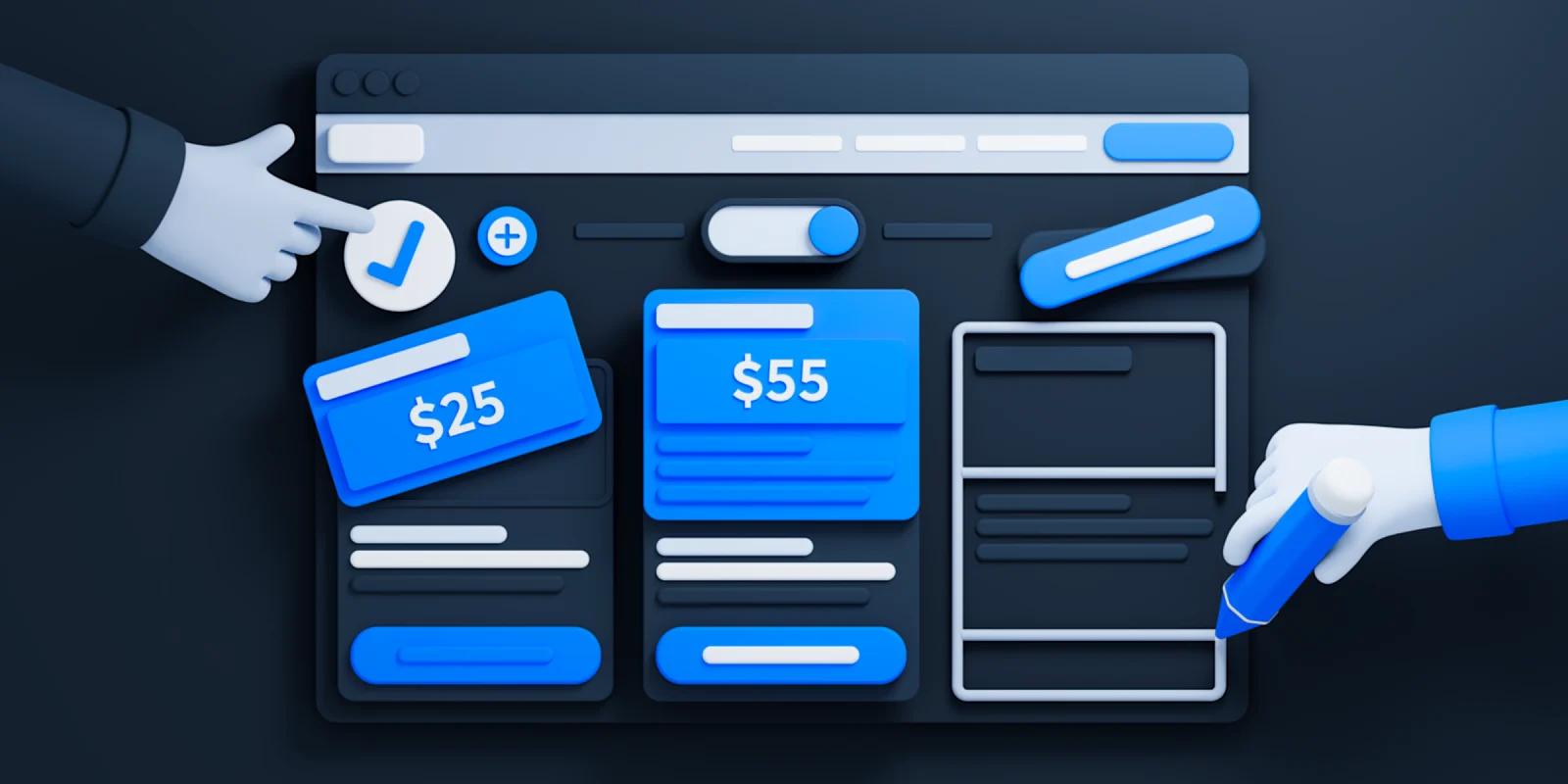As online experiences and website presence become increasingly integral to business success, a well-crafted UX strategy sets your digital assets for success and able to deliver measurable business value.
Discover how a strategic approach to UX design can transform your website into a powerful tool for growth.
In brief:
- Learn how a UX design strategy drives business growth.
- Discover the key components and steps to create and implement an effective UX strategy.
- Understand the benefits of a strong UX strategy on user engagement, conversion rates, and competitive advantage.
- Explore methods for continuous improvement of your UX strategy through user feedback and collaboration.

What is UX Design Strategy?
A successful UX strategy must intersect seamlessly with the company's business strategy. Aligning UX goals with broader business objectives makes sure that resources are allocated efficiently, focusing on features and experiences that truly drive business growth.
Such alignment enhances user satisfaction and translates to measurable business outcomes, such as improved conversion rates and customer loyalty. Integrating user-centered insights into the business strategy allows companies to create digital experiences that support both user engagement and business success. Incorporating strategic web design principles can further enhance this alignment.
Key Components of an Effective UX Strategy
An effective UX strategy starts with thorough user research and analysis. This helps you understand your target audience, their needs, and behaviors, informing every subsequent design decision. Conducting thorough research involves:
- Gathering insights about your current users.
- Analyzing competitors.
- Examining market trends to identify opportunities for differentiation.
Doing so ensures your strategy is grounded in real-world data and poised to meet user expectations.
User personas and journey maps are critical tools from this research process:
- User Personas: Creating detailed personas allows you to prioritize features that will deliver the most value.
- Journey Maps: Help you understand and optimize the paths users take when interacting with your product or service.
Steps to Create and Implement a UX Strategy
Creating and implementing a UX strategy requires a systematic approach to align user-centered experiences with your business objectives.
1. Conduct User Research
The foundation of a successful UX strategy lies in understanding your users. This requires comprehensive user research, employing both quantitative and qualitative methods:
- Quantitative Techniques:
- Qualitative Methods:
2. Engage Stakeholders and Cross-Functional Teams
Once you have gathered insights from user research, the next step is to engage stakeholders and cross-functional teams. To do this:
- Involve Stakeholders Early: Provides alignment with broader business objectives.
- Use Collaboration Techniques:
- Build Cross-Functional Teams:
- Enhance Collaboration:

Benefits and Business Impact of Strong UX Strategy
Placing users at the center of design decisions allows businesses to create more intuitive and satisfying experiences, leading to increased customer satisfaction and loyalty.
According to research, design-led companies have outperformed the S&P Index by 219% over ten years, demonstrating the tangible business impact of strong UX design. Adopting this approach turns user insights into powerful business outcomes.
Benefits of a strong UX design strategy include:
- Enhanced User Engagement and Satisfaction:
- Improved Conversion Rates:
- Strengthened Competitive Position:
- Alignment with Business Goals:
Real-world examples, such as increasing product demos with UX, demonstrate how a strong UX strategy can significantly impact key business metrics. For instance, Circle's redesign led to a 500% increase in product demos, showcasing the direct influence of UX on conversion rates.
By focusing on user experience, companies can optimize conversion rates; there are numerous strategies for improving CRO with UX, which directly contribute to business growth. Industry-specific approaches, such as applying MedTech UX design best practices, can further enhance the effectiveness of UX strategies by addressing sector-specific user needs and regulatory considerations. Similarly, incorporating Fintech UX design principles can help financial technology companies create user experiences that build trust and streamline complex transactions.
For instance, every dollar invested in UX brings a return of $100, representing an ROI of 9,900%. Ensuring UX efforts align with business goals supports revenue growth and secures long-term competitive advantages.
Continuous Iteration and Improvement Based on User Feedback
Creating an effective UX design strategy isn't a one-time effort but a continuous journey of refinement. At the heart of this process is ongoing user testing and feedback collection. This iterative approach fosters a more user-centric product.
To tailor your digital experiences accurately, you must consistently engage with your users. This involves:
- Conducting Regular Usability Tests: Observe how real users interact with your product.
- Gathering Qualitative Insights: Use interviews and surveys to uncover user pain points and areas for enhancement.
- Analyzing User Behavior: Employ quantitative methods like A/B testing to validate design decisions with empirical data.
Conduct User Research and Analysis to Inform Design Decisions
Conducting thorough user research and analysis is essential for making informed design decisions.
Methods for Gathering User Insights
- Quantitative Methods:
- Qualitative Methods:
- User Personas and Journey Mapping:
Additionally, incorporating Fintech keyword research can provide insights into user search behaviors, informing content strategy and SEO efforts that enhance user experience. For SaaS companies, applying effective SaaS keyword research strategies can help tailor content to user needs, thereby improving engagement and lead generation.
Engage Stakeholders and Foster Cross-Functional Collaboration
The process begins by conducting stakeholder interviews to gather insights and ensure alignment between user experience goals and business objectives. Regular and transparent communication is essential.
Building a cross-functional team is another key element. Involving individuals from various departments provides a shared understanding and commitment to the UX goals. Aligning your team bridges the gap between user-centered design and business objectives, creating a cohesive strategy.
Implementing a cohesive design system benefits not only the user experience but also streamlines collaboration among teams. Case studies like Workgrid's robust design system illustrate how a unified approach can reduce silos and enhance product development.
Securing stakeholder buy-in is also essential. Clearly communicating the value of UX initiatives and demonstrating their impact on business metrics can help gain support from leadership. Engaging stakeholders and fostering collaboration set a solid foundation for a UX strategy that is both user-centered and aligned with business growth objectives.
Is UX Design Strategy Worth It?
When evaluating the return on investment (ROI) of a UX design strategy, its impact extends beyond immediate financial gains. A well-crafted UX strategy enhances user engagement and satisfaction to contribute to higher conversion rates.
For SaaS companies, implementing effective SaaS UX design strategies can result in improved user adoption rates and reduced churn, further underscoring the value of a solid UX investment.
Investing in UX design not only improves user satisfaction but also has a significant impact on the bottom line. As per studies, companies that invest in UX see a lower cost of customer acquisition, lower support cost, increased customer retention, and increased market share.
Beyond immediate benefits, a strong UX strategy fosters long-term business value by creating consistent user experiences across platforms, which is essential in building a competitive advantage.

Realizing the Potential of UX Design Strategy
A thoughtfully crafted UX design strategy is one of the key ingredients for companies seeking to bridge the gap between their digital presence and business objectives. By staying abreast of emerging UX design trends, businesses can continually refine their strategies to meet evolving user expectations.
Additionally, integrating targeted content strategies, such as fintech content strategies, can complement your UX design efforts, resulting in content that aligns with user needs and enhances the overall experience.
Ready to optimize your SaaS website structure for growth? See the Webstacks difference: Schedule a brief discovery call today. Let us help you create a website that drives results.




